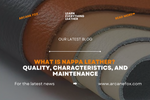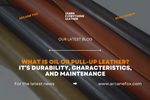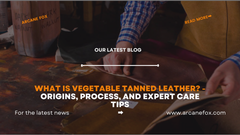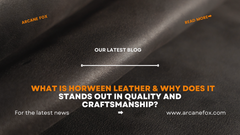What is Nubuck Leather? & How is it Different From Suede Leather
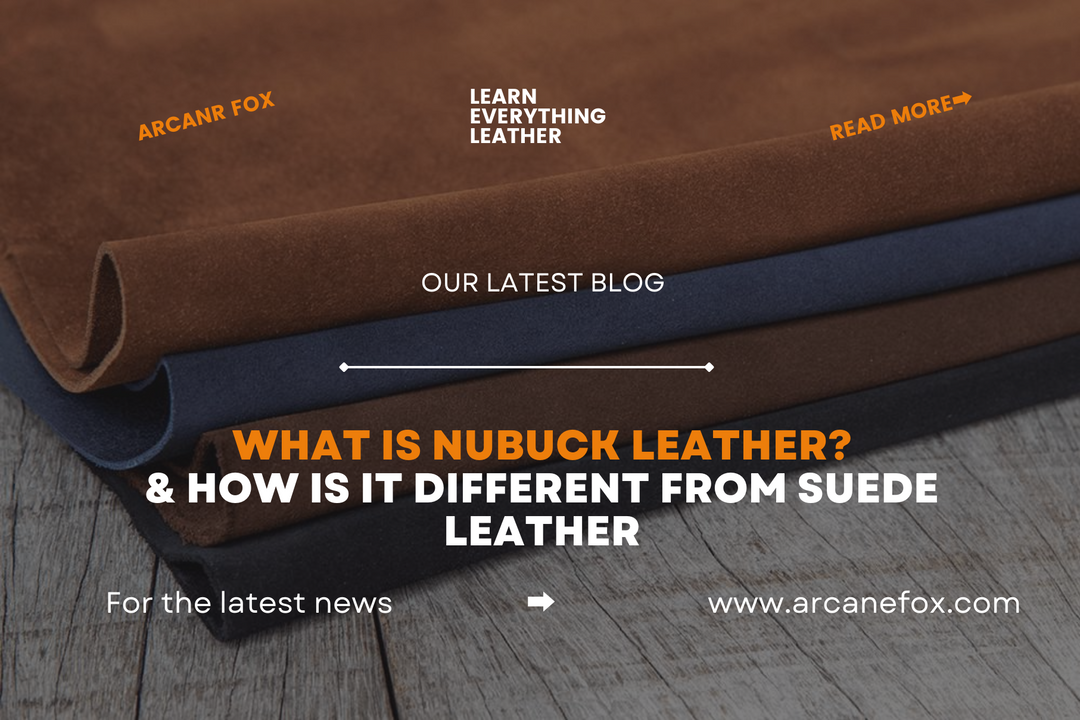
What is Nubuck Leather? & How is it Different From Suede Leather
Each type of leather is chosen for particular uses and leather goods due to its unique properties. Nubuck leather has a distinctive feel, is surprisingly tough, and supple.
A type of leather create from the top grain of the hide is call nubuck leather. Small, elevated fibers that are velvety soft to the touch cover its surface. Numerous leather products, such as jackets, shoes, gloves, and accessories for the individual, use nubuck, which is frequently coloured in a variety of colors.
Nubuck leather is quite a distinctive material that sticks out thanks to its surface texture. Let's look at how to achieve it and some leather goods that can benefit from it.
Key Takeaways for This Blog
You can count on getting a solid overview of the world of Nubuck leather in this extensive blog as well as a deep dive into its special qualities and traits. We'll look at how Nubuck varies from suede leather, where it came from, and the particular kinds of leather that were use to make it. You'll learn about Nubuck's benefits and drawbacks, as well as its durability and upkeep requirements. We'll also answer frequent misunderstandings and inquiries regarding Nubuck leather so that you have a complete understanding of this pricey material. Whether you're a leather connoisseur or you're just wondering about the nuances of Nubuck, this site will give you insightful knowledge.
1. What is Nubuck Leather?

A type of leather called nubuck has a surface with a velvety-soft texture. It is top grain leather, which is a sign of quality. It stands out from the majority of leathers because the surface is cover in numerous tiny elevate leather fibers. Although it has smooth, very short, compact fibers, it is practically "fuzzy".
The second-strongest type of leather that is typically utilize in Nubuck is Top Grain leather. This comes in second place to full grain, which keeps the outside surface of the hide, which is extremely compact, dense, and strong. The exterior grain is sand down to reveal the Top Grain below because the fibers wouldn't be visible in the Full Grain. The leather loses its apparent strength when the top grain is remove, but doing so also exposes the below fibers.
These fibers are raise and separated during the sanding process, giving the leather its "fuzzy" appearance. Let's examine the many leather layers and the exact origin of Nubuck. These fibers are relatively strong and resistant to wear since they are made from the top grain of the hide.
2. Make and Origin of Nubuck Leather
A soft, smooth surface is highlight by a light nap of small fibers or bristles, creating a special feel. This is frequently mistaken for suede when it's actually Nubuck. Nubuck is currently made of calfskin leather as well, despite being traditionally made from deer, moose, or elk. It has a delicate texture as a result. Given that nubuck is made from the top-grain or even full-grain (for enhanced durability) of leather, which is the outermost layer of skin or hide, it nearly always has a highly natural appearance that includes characteristics like birthmarks or flaws of various kinds. It receives this particularly eye-catching appearance and feel by being subject to sanding and buffing on the grain side.
2.1 Nubuck and Suede: A Misconception
Despite resembling suede in appearance and texture, nubuck is manufacture from the exterior of a hide or skin. In addition to the fine grain, this also increases thickness and strength. So, Nubuck is a stronger substitute for suede. Not to mention that Nubuck costs a little more than suede due to the lengthy leather dying procedure that is require to heavily infuse color to it in order to disguise all of the sanding that has been done.
Nubuck is frequently use in furniture, shoes, purses, bags, and apparel like leather jackets due to its resilience among other things. The reason is that these goods can withstand the test of time and will serve as ideal illustrations of durable goods.
2.2 Nubuck Leather vs Full-Grain Leather
We won't be able to realize that full-grain leather, even though it would be the second layer of skin, can also be use to make Nubuck until we realize that Nubuck leather is traditionally top-grain leather that has been treat and buffed from the outermost layer of the animal. In actuality, Nubuck made from full-grain leather will be more durable than that of top-grain leather.
2.3 Nubuck Leather vs Suede Leather

Simply said, the process of creating nubuck involves treating and sanding the skin's exterior layer, which is also resilient because of its thick, solid construction. Conversely, suede is the complete opposite. Made by turning the skin inside out and treating the inner layer. Because of this, Suede is not as strong and long-lasting as Nubuck. This also explains why Suede leather costs less money than Nubuck.
3. What is Nubuck Leather Made of?

The top grain, or outermost layer of the animal hide, is use to create nubuck leather. This layer, which is made up of thick collagen fibers, is often one of the strongest (only full grain is stronger). Let's examine each to learn more about the layers of the hide and the reasons why they differ.
3.1 Leather Hide – The Grain
The leather hide's outermost surface is call the grain. It is made up of very dense, compact fibers. Once the hair has been remove, the grain, which is the layer that was expose to the elements (air, rain, sun, etc.), is typically quite strong and smooth.
3.2 Leather Hide – The Grain and Corium Junction
The point at which the corium's loser fibers converge with the grain is known as the grain and corium junction. This juncture combines the more fibrous and looser fibers of the corium layer with the highly desired grain layer.
3.3 Leather Hide – Corium
Animal hides have a layer known as the corium that is primarily made of collagen fibers. Compared to the grain layer, these are more open and loose. However, making leather with this layer is really feasible. The corium is often the layer of an animal's hide that is the thickest. Therefore, after a hide is split, the corium may still be visible in top grain or genuine leather items.
3.4 Leather Hide – Flesh
The layer of the hide known as the flesh is primarily made up of fatty and muscular tissues. In terms of final leather uses, it is not very useful. As a result, leather is typically split in order to remove the layers above it, producing material that may be use in a variety of grades and qualities to make leather goods.
4. Why Nubuck Leather is Made from Top Grain?
The tightest, densest grain typically occurs in the layers of hide that are closest to the surface. This is due to the fact that the animal was protect by the skin that was closest to the ground. This can be the result of exposure to the sun, wind, rain, or daily abrasions.
The skin may hold more as one descends into its deeper layers, including fatty tissue and other organic materials. As a result, the collagen fibers were more flexible to accommodate all of these materials. Simply because the fibers are less dense, the leather from these layers, such as Split Leather, is not as robust as Top Grain and Full Grain leather.
In order to create the raised-fiber, texture side of nubuck leather, a piece of top grain leather must first have its outermost layer of dense fibers (the "grain side") sanded. Because it is Top Grain and the fibers are closely space, they produce a highly even, smooth texture when sanded and raised.
It's also important to keep in mind that Nubuck is made by sanding the surface exterior (or grain) side. This is so that the leather's fibers are more tightly woven the closer it is to the hide's original surface. Nubuck makes use of the surface on the outside. This is distinct from suede, a related substance. Sanding is done to the suede's inside ("flesh side") surface. There, the fibers are more flexible, giving the finished suede a more open texture. Although it is not as tight as Nubuck, it is nonetheless soft.
In general, nubuck leather is more expensive than suede. This is so that Nubuck's tighter grain, which is a little stronger and more durable, may be use. Also, it appears a little smoother. Therefore, a greater price also reflects these desired attributes.
5. How is Nubuck Leather Made?

The technique of tanning is use to create nubuck leather. Depending on the procedure working, tanning can take anywhere from days to months and involves up to 25 processes. A quick chromium tanning procedure is frequently use to tan Nubuck leathers.
Leathers produced by chromium tanning also take and keep colored dye reasonably well. This results in a very aesthetically pleasing, soft leather that may be use for a variety of leather goods, such as bags, gloves, purses, wallets, and other high-end leather products and accessories. Nubuck leathers are both physically supple and aesthetically appealing because they come in a variety of colors.
Soluble dyes are frequently use to color nubuck leather. These dyes give the leather its color by soaking into the fibers and coloring them without changing the surface. While some leathers have damage or imperfect surfaces that can be cover up with a layer of dye or color to conceal them, Nubuck natural, undamaged surface is one of its main selling points.
The quality of the Nubuck leather can be appreciate because the soluble colors allow the entire natural surface to show. Aniline leather refers to leather that has been color using soluble dyes. Nubuck is therefore an aniline leather with a smooth, velvety surface.
6. What Hides are Made Into Nubuck Leather?

In the start of time, moose, elk, and deer hides predominated. These wild animals were frequently sought for both their natural resources and for sustenance. A highly important resource, hides were utilize to create tools, clothing, and shelter. The hides would be polish and scraped, with some of them having the softer texture now associate with Nubuck leather.
Today, it is most frequently derive from the hides of cows (calf), sheep, and goats. The majority of hides, including the formerly well-liked deer, elk, and moose, can be use to make it, though.
7. What is Nubuck Leather Use For?

In a variety of products where durability is important, such as purses, briefcases, travel bags, pouches, jackets, boots, shoes, and sandals, furniture and automotive upholstery, belts, wallets, gloves, notebook covers, coverings for devices and mobile phones, and keychains, nubuck is use.
8. Advantages and Disadvantages of Nubuck
Nubuck is resilient, breathable, and long-lasting. Three encouraging aspects that promote Nubuck purchasing. Not to mention how amazing it looks and feels, it is extremely comfortable. giving the wearer a luxurious appearance. It is possibly the only form of leather that doesn't require as much complicated upkeep as other varieties of leather often do, such as polishing or shining. Unless an unexpect accident necessitates extensive cleaning, Nubuck only has to be clean occasionally. Negatively, if Nubuck is subject to harsh factors such excessive mud, grime, or dust, it may degrade, discolor, or damage. Wetting Nubuck should always be avoid, as it will darken and lose its distinctive bristle structure upon drying due to the weakening and eventual breaking of the fibers.
9. How to Clean Nubuck Leather?

It is recommend that you begin by using a high-quality dry brush to remove any loose sand or dust from the surface before using a suede rubber to carefully remove any stains or blotches. Nubuck leather should not be clean with liquids, just like suede leather. Unless it's being clean by a pro.
10. Comparison of Nubuck Leather with other Leathers
Due to its distinctiveness, durability, and susceptibility to damage, Nubuck is sometimes confuse with or mistaken for many different varieties of leather. Due to their similar appearance, suede and nubuck are frequently mistaken for one another. Many will concur that Nubuck and Suede are excellent options based on cost and durability when considering all the other types of leather, including chrome coloured leather and vegetable leather.
10.1 Chrome-Dyed Leather and Nubuck
The feel of chrome-dyed leather is somewhat similar to that of Nubuck, despite the fact that they look very different. The hide or skin must first be tan before being dye to achieve the desire appearance for this sort of dye leather. Interesting distinctions between both include the fact that nubuck is less resilient to water, less durable, and more susceptible to stains.
Vegetable leather is create by tanning the hide or skin in tannins derived from tree bark. Smooth appearance that with time acquires a certain patina that leather aficionados prefer in their items.
11. Conclusion
If one had to draw a conclusion on the definition of nubuck leather, it would be as follows: Nubuck is as supple and smooth as it is strong and long-lasting. Despite the fact that they are fundamentally different, it is frequently mistaken for suede due to the way they both look. In order to create Nubuck, the skin or hides' outer layers are sand and polish. Despite its durability, it is quickly damage by mud, dust, or rain. Once wet, it is very challenging—and frequently impossible—to restore the material's original texture and look. Contrary to popular opinion, full-grain leather can also be use to create Nubuck, which is a popular misconception about the material. The latter is tougher.
Learn more about leather here Leather 101 - The Ultimate Guide to Different Types of Leather
Related Topics
What is Aniline Leather? Types of Aniline, Characteristics, And More
What is Semi-Aniline Leather? History, Characteristics, And More
What is Burnished Leather? & Why Should It’s Be Your Top Choice
What is Antique Leather? & Why it is So Popular
What is Bicast Leather? Myths, Facts, and Benefits
What is Embossed Leather? & How to Use This Process
What is Embroidery Leather? & What to Look for In Leather Embroidery?
What is Faux Leather? It’s Quality & Durability Against Other Leather!
What is Nappa Leather? Quality, Characteristics, and Maintenance
What is Oil or Pull-Up Leather? It’s Durability, Characteristics, and Maintenance
What is Patent Leather? & How to Maintain It’s Quality and Shining
What is Pigmented Leather? How is it Made, It's uses and characteristics
What is Suede Leather? & The Difference Between Suede and Nubuck Leather?

